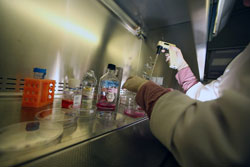Cutting the blood supply of tumour cells
Heparanase is an enzyme that acts on heparan sulphate (HS) thereby releasing growth factors that are implicated in tumour cell proliferation, metastasis and angiogenesis. Angiogenesis or the development of blood supply for the cancer cells is a prerequisite for tumour enlargement and subsequent metastasis when tumour cells spread to other parts of the body. In order to develop suitable angiogenesis inhibitors, it is necessary to determine the complex sequences of heparan sulphate and other structurally related molecules. The use of mono-dimensional nuclear magnetic resonance (NMR) spectroscopy is limited because of the manifestation of signal overlap. The team at Istituto di Ricerche Chimiche and Biochimiche G. Ronzoni in Italy investigated heteronuclear single quantum coherence (HSQC) spectroscopy which yields a two dimensional result. They discovered that with the appropriate signals the desired higher resolution was achieved for quantitative measurements with HSQC. The method was evaluated to determine the structure of the heparin and heparan sulphate molecules that had various substitutions. HS mimics were obtained by replacing reactive side groups with sulphate groups. Some of these molecules served successfully as heparanase inhibitors to prevent the progression of the deadly pathway. The same team also established a reliable method to study the extent that heparanase cleaves its substrate molecule. They set up an on-line liquid chromatography/mass spectrometry method. This works at nanomolar concentrations and does not require radioactive or fluorofore detection. They found that the molecule is cut at a certain five-sugar sequence even if it is not part of a larger sugar molecule. Moreover, this sequence is available as a commercial product and it can therefore be used as a substrate to replace HS molecules that are difficult to produce or have to be extracted from animals. The successful development of anticancer drugs based on molecular mimics is a specific, non-invasive way to treat cancer. The results of this team's work therefore represent several potential steps in the use and testing of molecular inhibitors of the angiogenesis process.







